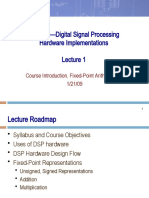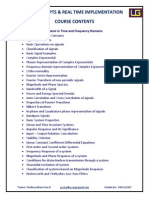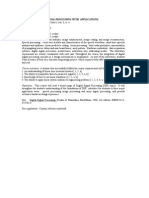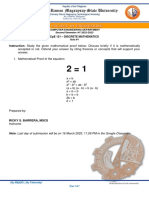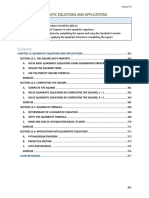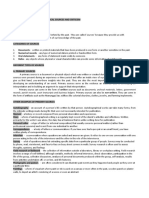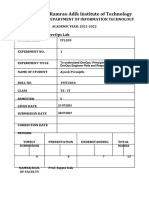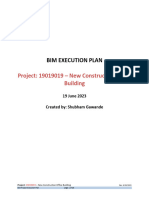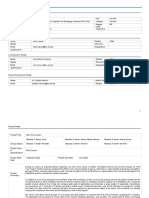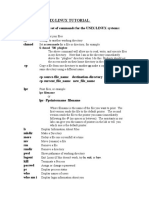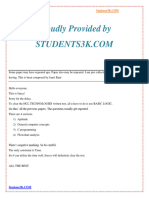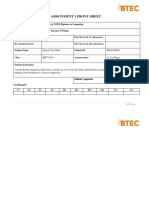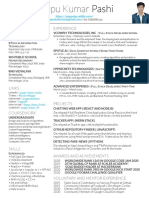Digital Signal Processing
Chapter 2
Relevant Tools, Standards, and/or
Engineering Constraints
Subtopic 1: Software Tools for DSP
Subtopic 2: Hardware Platforms
Subtopic 3: Engineering Constraints
Subtopic 4: Standards in DSP
Subtopic 5: Development Workflow
10
This instructional material is intended solely for the CPE 414 class of President Ramon Magsaysay
State University – Bachelor of Science in Computer Engineering, Academic Year 2025–2026, First
Semester. Unauthorized copying, distribution, or sharing of any part of this document is strictly
prohibited.
�Chapter 2
Relevant Tools, Standards, and/or Engineering
Constraints
Introduction
Digital Signal Processing (DSP) is not just about theory—it’s about applying the right
tools, adhering to established standards, and navigating engineering constraints to create
efficient, reliable, and scalable systems. In this chapter, you will explore the essential tools and
software used in DSP, such as MATLAB, Python, and specialized hardware like Digital Signal
Processors. These tools empower engineers to model, simulate, and implement DSP systems
with precision.
You will also learn about the critical role of standards in ensuring compatibility,
interoperability, and quality across industries. Standards like the Nyquist-Shannon sampling
theorem, IEEE floating-point formats, and audio/video compression protocols (e.g., MP3,
JPEG) provide a framework for designing systems that meet global benchmarks.
Furthermore, we will examine the engineering constraints that influence DSP design,
such as computational complexity, memory limitations, power consumption, and real-time
processing requirements. Understanding these constraints is key to making informed trade-offs
and delivering optimized solutions in real-world applications.
Specific Objectives
At the end of the lesson, the students should be able to:
- Identify key software and hardware tools used in DSP applications.
- Discuss relevant standards that guide DSP development and interoperability.
- Evaluate engineering trade-offs involved in DSP system design.
- Understand the limitations imposed by hardware resources on algorithm
implementation.
11
This instructional material is intended solely for the CPE 414 class of President Ramon Magsaysay
State University – Bachelor of Science in Computer Engineering, Academic Year 2025–2026, First
Semester. Unauthorized copying, distribution, or sharing of any part of this document is strictly
prohibited.
�Lesson Proper
A solid understanding of the tools and constraints in DSP is critical to developing
efficient systems. DSP practitioners rely on both software and hardware environments for
design, testing, and deployment.
Software Tools for DSP
Software platforms enable modeling, simulation, and
prototyping of DSP systems before hardware
implementation. Common tools include:
Tool Description
High-level environment for algorithm design and simulation.
MATLAB
Includes extensive DSP libraries.
Add-on to MATLAB for system-level modeling with block
Simulink
diagrams. Ideal for real-time simulations.
Open-source MATLAB-compatible platform. Useful for basic
GNU Octave
algorithm prototyping.
Python Popular for DSP tasks, especially in academic and research
(NumPy/SciPy) settings. Supports array-based computation.
Used in measurement and control systems with graphical
LabVIEW
programming capabilities.
These tools allow users to develop and visualize filters, spectral transforms, and signal
processing pipelines in a simulated environment.
12
This instructional material is intended solely for the CPE 414 class of President Ramon Magsaysay
State University – Bachelor of Science in Computer Engineering, Academic Year 2025–2026, First
Semester. Unauthorized copying, distribution, or sharing of any part of this document is strictly
prohibited.
�Hardware Platforms
When moving to real-time or embedded systems, specialized hardware is used:
DSP Chips: TI’s TMS320 series, Analog Devices’ SHARC
processors.
Microcontrollers (MCUs): Suitable for low-power, simple
DSP tasks.
FPGAs: Offer parallel processing capabilities and flexibility
in implementing custom architectures.
GPUs: Increasingly used for high-throughput DSP such as video and machine learning
tasks.
Engineering Constraints
Real-world DSP systems are subject to constraints such as:
a. Memory and Storage: Limited in embedded systems.
b. Processing Speed: Must meet real-time performance requirements.
c. Power Consumption: Especially important in battery-powered applications.
d. Latency: Critical in control systems and communication.
Example: In a hearing aid, the DSP chip must filter
background noise and amplify speech with less than
10 ms latency while operating under strict power
limits.
13
This instructional material is intended solely for the CPE 414 class of President Ramon Magsaysay
State University – Bachelor of Science in Computer Engineering, Academic Year 2025–2026, First
Semester. Unauthorized copying, distribution, or sharing of any part of this document is strictly
prohibited.
�Standards in DSP
Standards ensure compatibility and reliable performance. Key standards include:
IEEE 754: Defines formats for floating-point arithmetic.
ITU-T Standards: e.g., G.711 for audio codecs.
MPEG/JPEG: Standards for video and image compression.
ISO/IEC: Guidelines for data formats and interoperability.
These standards are crucial for developers working on devices that must communicate or
operate with other systems.
Development Workflow
1. Modeling: Using MATLAB/Python to test algorithms.
2. Simulation: System-level testing in Simulink or
hardware-in-the-loop.
3. Implementation: Porting code to C/C++ or using code
generation tools.
4. Testing: Verifying accuracy, latency, and stability.
5. Optimization: Reducing memory, CPU cycles, or
power.
14
This instructional material is intended solely for the CPE 414 class of President Ramon Magsaysay
State University – Bachelor of Science in Computer Engineering, Academic Year 2025–2026, First
Semester. Unauthorized copying, distribution, or sharing of any part of this document is strictly
prohibited.
�References/Additional Resources/Readings
Kuo, S. M., Lee, B. H., & Tian, W. (2013). Real-Time Digital Signal Processing:
Fundamentals, Implementations, and Applications (3rd ed.). Wiley. Retrieved July 2025, from:
https://students.aiu.edu/submissions/profiles/resources/onlineBook/H7Y7t7_Real-
Time_Digital_Signal_Processing_Applications-_3rd.pdf
Parker, M. (2017). Digital Signal Processing 101: Everything You Need to Know to Get Started
(2nd ed.). Elsevier. Retrieved July 2025, from:
https://picture.iczhiku.com/resource/eetop/sYkSzhfSWyLrfBcB.pdf
Stock images from Canva. (2025). Canva. Retrieved July 2025, from https://www.canva.com
Texas Instruments. (2020). TMS320C55x DSP Generation Overview. Retrieved from
https://www.ti.com/
The MathWorks, Inc. (2023). MATLAB Documentation. Retrieved from
https://www.mathworks.com/help/
15
This instructional material is intended solely for the CPE 414 class of President Ramon Magsaysay
State University – Bachelor of Science in Computer Engineering, Academic Year 2025–2026, First
Semester. Unauthorized copying, distribution, or sharing of any part of this document is strictly
prohibited.
�Activity
Activity 2
Name: _______________________________________________Score: ________________
Program/Year/Section: _____ ________ Course Code:_________ Date: _________________
Direction:
● Carefully read each question and ensure you understand the requirements before
answering. Provide clear and concise responses, adhering to the specified word counts
for each question. Where applicable, include diagrams, timelines, or examples to
support your answers.
● Include citations where necessary using APA format.
● All answers must be handwritten on A4 size bond papers before converting into a digital
format.
● Submit your answers in a single PDF document through the GClassroom by the
deadline using the file name <Surname,First Name_Course Code_Activity#>. Ensure
your document is well-organized and labeled with your name and activity title.
Questions:
1. Which of the following tools is commonly used for simulating and analyzing DSP
systems? Explain your answer.
a. AutoCAD c. SolidWorks
b. MATLAB d. Blender
2. What does the Nyquist-Shannon sampling theorem state about the sampling rate of a
signal? Defend your answer in more than 100 words.
a. The sampling rate must be equal to the signal's frequency.
b. The sampling rate must be at least twice the signal's highest frequency.
c. The sampling rate must be less than the signal's highest frequency.
d. The sampling rate is irrelevant to signal reconstruction.
3. Which of the following is an example of an engineering constraint in DSP system
design? Explain your answer.
a. Unlimited memory availability
b. Real-time processing requirements
c. Absence of power consumption limits
d. Infinite computational resources
16
This instructional material is intended solely for the CPE 414 class of President Ramon Magsaysay
State University – Bachelor of Science in Computer Engineering, Academic Year 2025–2026, First
Semester. Unauthorized copying, distribution, or sharing of any part of this document is strictly
prohibited.



